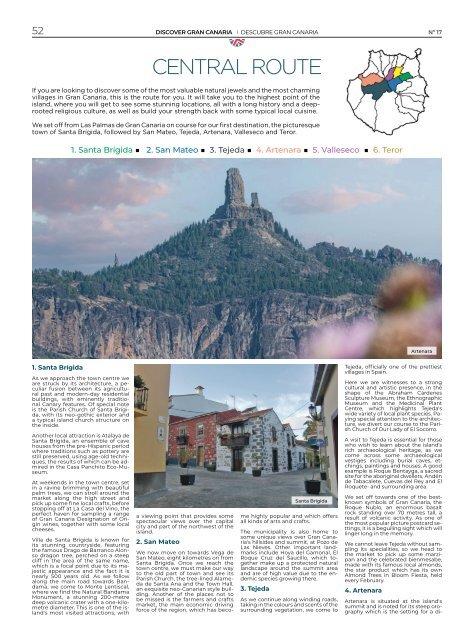No. 17 - Its Gran Canaria Magazine
Rutas, recomendaciones y noticias de Gran Canaria. Routes, tips and news about Gran Canaria.
Rutas, recomendaciones y noticias de Gran Canaria.
Routes, tips and news about Gran Canaria.
Create successful ePaper yourself
Turn your PDF publications into a flip-book with our unique Google optimized e-Paper software.
52<br />
DISCOVER GRAN CANARIA I DESCUBRE GRAN CANARIA Nº <strong>17</strong><br />
CENTRAL ROUTE<br />
If you are looking to discover some of the most valuable natural jewels and the most charming<br />
villages in <strong>Gran</strong> <strong>Canaria</strong>, this is the route for you. It will take you to the highest point of the<br />
island, where you will get to see some stunning locations, all with a long history and a deeprooted<br />
religious culture, as well as build your strength back with some typical local cuisine.<br />
We set off from Las Palmas de <strong>Gran</strong> <strong>Canaria</strong> on course for our first destination, the picturesque<br />
town of Santa Brígida, followed by San Mateo, Tejeda, Artenara, Valleseco and Teror.<br />
1. Santa Brígida ■ 2. San Mateo ■ 3. Tejeda ■ 4. Artenara ■ 5. Valleseco ■ 6. Teror<br />
Artenara<br />
1. Santa Brígida<br />
As we approach the town centre we<br />
are struck by its architecture, a peculiar<br />
fusion between its agricultural<br />
past and modern-day residential<br />
buildings, with eminently traditional<br />
Canary features. Of special note<br />
is the Parish Church of Santa Brígida,<br />
with its neo-gothic exterior and<br />
a typical island church structure on<br />
the inside.<br />
Another local attraction is Atalaya de<br />
Santa Brígida, an ensemble of cave<br />
houses from the pre-Hispanic period<br />
where traditions such as pottery are<br />
still preserved, using age-old techniques,<br />
the results of which can be admired<br />
in the Casa Panchito Eco-Museum.<br />
At weekends in the town centre, set<br />
in a ravine brimming with beautiful<br />
palm trees, we can stroll around the<br />
market along the high street and<br />
pick up some fine local crafts, before<br />
stopping off at La Casa del Vino, the<br />
perfect haven for sampling a range<br />
of <strong>Gran</strong> <strong>Canaria</strong> Designation of Origin<br />
wines, together with some local<br />
cheeses.<br />
Villa de Santa Brígida is known for<br />
its stunning countryside, featuring<br />
the famous Drago de Barranco Alonso<br />
dragon tree, perched on a steep<br />
cliff in the area of the same name,<br />
which is a focal point due to its majestic<br />
appearance and the fact it is<br />
nearly 500 years old. As we follow<br />
along the main road towards Bandama,<br />
we come to Monte Lentiscal,<br />
where we find the Natural Bandama<br />
Monument, a stunning 200-metre<br />
deep volcanic crater with a one-kilometre<br />
diameter. This is one of the island's<br />
most visited attractions, with<br />
a viewing point that provides some<br />
spectacular views over the capital<br />
city and part of the northwest of the<br />
island.<br />
2. San Mateo<br />
We now move on towards Vega de<br />
San Mateo, eight kilometres on from<br />
Santa Brígida. Once we reach the<br />
town centre, we must make our way<br />
to the old part of town and see its<br />
Parish Church, the tree-lined Alameda<br />
de Santa Ana and the Town Hall,<br />
an exquisite neo-<strong>Canaria</strong>n style building.<br />
Another of the places not to<br />
be missed is the farmers and crafts<br />
market, the main economic driving<br />
force of the region, which has become<br />
highly popular and which offers<br />
all kinds of arts and crafts.<br />
The municipality is also home to<br />
some unique views over <strong>Gran</strong> <strong>Canaria</strong>'s<br />
hillsides and summit, at Pozo de<br />
Las Nieves. Other important landmarks<br />
include Hoya del Gamonal, El<br />
Roque Cruz del Saucillo, which together<br />
make up a protected natural<br />
landscape around the summit area<br />
and are of high value due to the endemic<br />
species growing there.<br />
3. Tejeda<br />
Santa Brígida<br />
As we continue along winding roads,<br />
taking in the colours and scents of the<br />
surrounding vegetation, we come to<br />
Tejeda, officially one of the prettiest<br />
villages in Spain.<br />
Here we are witnesses to a strong<br />
cultural and artistic presence, in the<br />
shape of the Abraham Cárdenes<br />
Sculpture Museum, the Ethnographic<br />
Museum and the Medicinal Plant<br />
Centre, which highlights Tejeda's<br />
wide variety of local plant species. Paying<br />
special attention to the architecture,<br />
we divert our course to the Parish<br />
Church of Our Lady of El Socorro.<br />
A visit to Tejeda is essential for those<br />
who wish to learn about the island's<br />
rich archaeological heritage, as we<br />
come across some archaeological<br />
vestiges including burial caves, etchings,<br />
paintings and houses. A good<br />
example is Roque Bentayga, a sacred<br />
site for the aboriginal dwellers, Andén<br />
de Tabacalete, Cuevas del Rey and El<br />
Roquete- and surrounding area.<br />
We set off towards one of the bestknown<br />
symbols of <strong>Gran</strong> <strong>Canaria</strong>, the<br />
Roque Nublo, an enormous basalt<br />
rock standing over 70 metres tall, a<br />
result of volcanic activity. As one of<br />
the most popular picture postcard settings,<br />
it is a beguiling sight which will<br />
linger long in the memory.<br />
We cannot leave Tejeda without sampling<br />
its specialities, so we head to<br />
the market to pick up some marzipan<br />
and the celebrated bienmesabe,<br />
made with its famous local almonds,<br />
the star product which has its own<br />
Almond Trees in Bloom Fiesta, held<br />
every February.<br />
4. Artenara<br />
Artenara is situated at the island's<br />
summit and is noted for its steep orography<br />
which is the setting for a di-

















